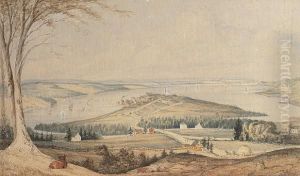Duchess Elizabeth Of Sutherland Paintings
Elizabeth Leveson-Gower, Duchess of Sutherland (née Sutherland), was not an artist in the traditional sense but rather a notable figure in British history, primarily recognized for her role as a landowner and her involvement in the Highland Clearances during the early 19th century. Born on May 24, 1765, into the Scottish nobility, she became Countess of Sutherland in her own right and was later married to George Granville Leveson-Gower, who became the Marquess of Stafford and subsequently the first Duke of Sutherland.
The Duchess of Sutherland is often remembered for her significant influence on the agricultural and social landscape of the Scottish Highlands. Her tenure saw the controversial Highland Clearances, a series of forced evictions that took place during the late 18th and 19th centuries. Landowners, including the Duchess, aimed to restructure their estates from the traditional clan system to make way for sheep farming, which was more profitable than the traditional crofting practiced by the tenants.
This period of change led to widespread displacement of the local population, with many tenants being forcibly removed from their ancestral lands. The clearances resulted in significant emigration from Scotland to places like North America and Australia, as well as migration to industrial cities in Scotland and England. The actions of the Duchess and her factors (estate managers) have been the subject of much historical debate and are often viewed as a dark chapter in Scottish history.
Despite the controversy surrounding her role in the Clearances, Elizabeth was also known for her interest in the improvement of her estates and the welfare of her tenants, although this is overshadowed by the harsh realities of the Clearances. She was involved in the creation of new towns and the promotion of industries such as fishing and textile production, which were intended to provide alternative livelihoods for those affected by the changes in land use.
The Duchess of Sutherland passed away on January 29, 1839. Her legacy is complex, as it includes both the development and modernization of her estates and the tragic social impact of the Clearances. She remains a figure of historical significance, embodying the tensions between progress and tradition, and the human cost of economic transformation in rural Scotland.
